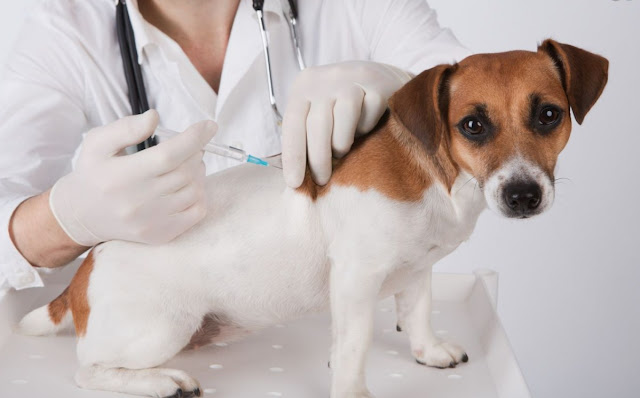The canine distemper virus manifests itself in two different forms. A more common of the form manifests itself in the intestinal form. Canine parvovirus is a deadly and contagious virus that affects all types of dog breeds. There is a greater risk of the spread of the disease among young puppies which are four months old. Dogs that are infected by the virus are said to have parvovirous disease. The disease can be spread directly from one dog to another. Its main mode of spreading is through the contact with infected dogs.
 Diagnosis of canine parvovirus disease
Diagnosis of canine parvovirus disease
To diagnose the disease, most veterinary officers recommend you to have a brief history of your dog health and vaccination history.
The disease can be diagnosed through the physical examination of the infected animal. Conducting biochemical tests, abdominal ultrasounds and radiograph are other forms through which the disease can be diagnosed.
As a dog owner, you will be required to take your dog to a veterinary officer immediately you see the sign and symptoms of the disease. Your veterinary officer will conduct a chemical blood profile and a complete red blood cell count. A low blood cell count will indicate Canine parvo infection
A biochemical and urine analysis will be a good diagnosis of the disease. The advantage of the method of diagnosis is that it indicates the level of urine and elevated liver enzymes. The conduction of an abdominal radiograph will indicate an intestinal obstruction. With an abdominal ultrasound
For proper diagnosis, you will need to do a little research on your pet health. Check out the recent activities of your pet, check out the rate at which your dog exercises. Compare the rates with the previous level of activity. You can also gather your dog stool or vomit. The samples will help the veterinary officer in the detection of the virus.
Canine parvovirus disease clinical signs
The most affected organs by the disease are the digestive system and the heart. As a dog owner, you must realize that there can be subclinical infection with minimal signs of lethargy. Appetite loss in dog s can be for a period of at most two days.
The prevalent clinical signs of the disease include a vomiting, the production of a foul smell in dogs and diarrhea. Other symptoms of the disease include fever, depression, dehydration and weakness.
With the administration of a white blood sample count, infected dogs will register lower number of white blood cells.
Causes of canine parvovirus disease
In most situations, the disease is caused by an alteration of the canine parvo virus type 2b.A dog vulnerability to the disease can be increased by a wide array of factors. The common modes of transmission of the disease include a direct contact with an infected dog or through the oral –feacal route.
Human beings can also be causative agents of the spread of canine parvo disease. To the dog environment, the virus can be brought into a dog kennel by the mode of shoes. Through the stepping of a dog feacal deposit you can be a good causative agent of the spread of the disease. At any instance you suspect you have come into contact with the virus, always wash the affected area with household’s bleaches to kill the virus.
With an inadequate vaccination control, there will be a higher rate of Canine parvo infection. Thus Breeding places alongside dog shelters are hazardous environment for your dog since at most time the places are improperly vaccinated.
 Treatment of canine parvovirus disease
Treatment of canine parvovirus disease
Canine parvo treatment depends on the disease severity. Beside the disease severity the treatment banks on symptoms management to eliminate the virus out of the host body. Treatment entails the use of fluid therapy to control dehydration
The initiation of aggressive therapy during the early stage of the disease will help in excellent recovery. Under rare cases due fatalities occur unless there was late detection of the disease. Caged puppies will have a higher mortality rate since the diagnosis and recognition of the signs and symptoms usually takes a while.
A worrying fact is that the disease can spread at a higher rate in adult dogs. This is due to the fact that the adult’s dog never shows any symptoms of the disease in the early stages. The incubation period between the receipts of the symptoms and exposure is at most 6 days.
With this incubation period, you will be required to carefully examine a dog for a week before purchase or adoption of a new dog. I bet you don’t want to bring a new member into your family only to realize that your four legged friend has been infected by the canine parvo virus Examples of dog breed that are much affected by the diseases include the German shepherd, pit bulls and Labrador retrievers. The use of antibiotics may be used to secondary bacterial infection
Transmission of canine parvovirus dog diseases
The disease can be spread through an exposure to infected dog feces and through a dog contact with contaminated objects. Examples of common contaminated objects include dog instruments, dog clothing, beddings and dog food and dishes.
The virus can survive on the contaminated object for a long period of time and it can serve as a basic means of transmissions to other objects. With proper knowledge of the shedding pattern of the virus, you can create an effective treatment plan. The parvo virus infected dogs shed their feaces with the infected virus with a period of 3 to 4 days. Most veterinary officers affirms that the fatal rate percentage of the disease is between 16- 48 {6be2db3b88870d4886eebf8b9afca4bb83e0a042bc3cf1b41260af04e7c2bfbe}.
Prevention of canine parvovirus disease
The best method to prevent the disease through vaccination. There are different types of vaccination available for your dog. Consult your veterinary officer for the best vaccination type as per your dog breed.
In most circumstances, the vaccination period for the first vaccine is between 6-8 weeks for puppies and 16-20 weeks. As dog owner, you will be required to take good care of your dog. Carry out a proper home and disinfection for various dog appliances.
